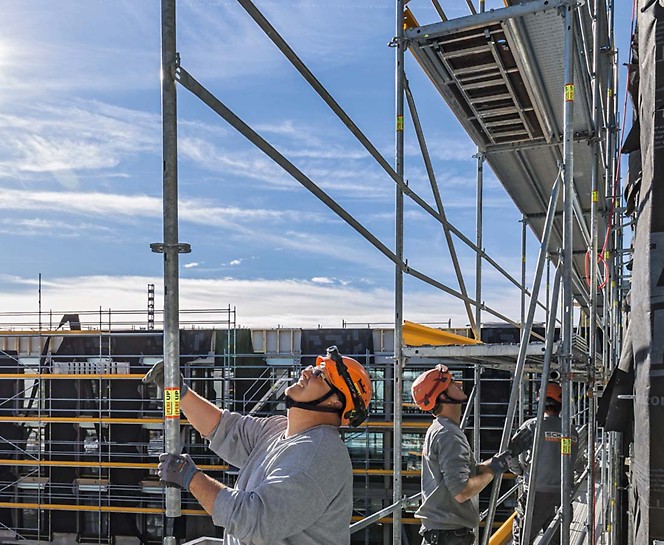The Benefits of Scaffolding for Safety and Effectiveness in Structure Projects
Scaffolding is a vital part in the realm of building and construction, dramatically contributing to both security and operational efficiency. The impact of scaffolding expands past basic safety and security steps; its tactical execution can transform job timelines and outcomes (Scaffolding).
Improved Worker Safety And Security

Improved worker safety is a paramount problem in the construction sector, where the dangers connected with drops and crashes can have dire effects. Efficient scaffolding systems play a critical duty in alleviating these hazards by supplying steady systems for employees at elevated heights. By making sure that scaffolding is properly erected and maintained, construction companies can considerably lower the chance of falls, which are among the leading sources of office injuries and fatalities.
In addition, scaffolding boosts security with its layout attributes. Guardrails, toe boards, and non-slip surfaces contribute to a protected working setting, minimizing the danger of mishaps. Additionally, scaffolding allows employees to gain access to hard-to-reach areas without the requirement for makeshift services, which can compromise safety standards.
Educating workers on the appropriate use of scaffolding is just as important. Ensuring that employees are experienced about lots capabilities, assembly procedures, and security protocols additionally boosts the efficiency of scaffolding in stopping crashes. To conclude, incorporating robust scaffolding systems within construction jobs not only enhances employee safety and security yet likewise promotes a society of safety that profits the entire labor force while improving total efficiency.
Improved Accessibility and Flexibility

Additionally, scaffolding permits the hassle-free transport of products and tools, lessening downtime related to relocating tools. Employees can effectively access numerous areas of a task, which is especially essential in intricate builds where vertical and straight movement is regular - Scaffolding. This availability not only enhances operations however additionally enables groups to respond promptly to altering job needs
Furthermore, scaffolding can be customized to fit particular site conditions, improving flexibility in limited or uneven spaces. This flexibility guarantees that building and construction tasks can proceed efficiently, regardless of the difficulties presented by the setting. By cultivating better gain access to and flexibility, scaffolding plays an essential duty in supporting building and construction teams and optimizing the overall effectiveness of structure projects.
Boosted Task Efficiency
In construction, task effectiveness is significantly influenced by the efficient use scaffolding systems. By offering a safe and stable platform for employees, scaffolding reduces downtime and increases the pace of building and construction activities. With improved accessibility to raised work locations, groups can complete tasks extra try this rapidly, decreasing the general project timeline.
The modular nature of contemporary scaffolding permits rapid assembly and disassembly, making it possible for swift shifts in between various phases of a project. This flexibility not just enhances workflow however likewise adds to much better sychronisation amongst numerous professions, as multiple teams can work all at once on different areas of a structure.
Furthermore, scaffolding ensures that workers are positioned properly to perform their tasks without unneeded pressure or threat of injury, thereby decreasing the probability of crashes that can bring about pricey hold-ups. Enhanced precaution embedded in scaffolding systems, such as guardrails and toe boards, further support efficient procedures by keeping employee emphasis on the task at hand rather than safety concerns.

Flexibility for Different Jobs
Scaffolding systems stand apart for their adaptability throughout a large range of building and construction jobs, qualified of meeting specific website requirements and tasks. Their modular layout permits fast modifications to accommodate different building kinds, from domestic to business structures, ensuring that workers have secure gain access to at various heights and angles.
These systems can be customized for varied applications, such as façade work, indoor renovations, or sturdy commercial jobs. Light-weight aluminum scaffolds are optimal for interior job, while robust steel structures supply the required support for large-scale building and construction. The adaptability scaffolding in learning of scaffolding encompasses its capability to be set up for both temporary and long-term structures, allowing specialists to successfully intend and execute their projects.
Furthermore, scaffolding can be utilized in difficult atmospheres, including city settings where space is limited or on uneven surface where traditional access services are unwise. This versatility decreases the need for several gain access to options, minimizing expenses and job timelines. By suiting a selection of conditions and tasks, scaffolding enhances the overall efficiency and performance of construction initiatives, confirming to be an important possession in the structure market.
Compliance With Safety Standards
Exactly how can construction jobs ensure the safety and security of workers while preserving performance? Regulatory structures, such as OSHA in the United States, supply standards that govern the use of scaffolding, making certain that it satisfies rigid safety requirements.
Correct scaffolding design and setup play a crucial role in conformity. Scaffolds have to be constructed from top notch materials and created to withstand the particular lots they will experience. Normal examinations and maintenance are important to guarantee that these frameworks stay secure throughout the project duration. Educating employees on secure scaffold usage and the relevance of conformity with safety standards additionally strengthens a culture of security on-site.
Additionally, documentation and record-keeping related to safety inspections and employee training are essential. These techniques not just demonstrate compliance however likewise offer accountability and openness. Eventually, by prioritizing adherence to safety criteria, building jobs can foster a more secure workplace, therefore boosting efficiency and effectiveness without compromising employee safety.
Verdict
In verdict, scaffolding works as a vital part in building tasks, dramatically improving safety and performance. Its style attributes, including guardrails and non-slip surface areas, add to a more secure working environment while promoting enhanced accessibility and movement for employees. The modular nature of scaffolding advertises quick assembly, hence increasing general project efficiency. scaffolding joint pin In addition, adherence to safety criteria underscores the value of scaffolding in achieving successful job end results, making it important in the construction industry.
Scaffolding is an important element in the realm of building, dramatically adding to both safety and security and functional performance. The influence of scaffolding expands past standard safety and security measures; its tactical execution can change task timelines and end results. In verdict, including durable scaffolding systems within building and construction tasks not just enhances worker safety but likewise advertises a society of safety that benefits the entire workforce while enhancing general productivity.
In verdict, scaffolding offers as an important element in building tasks, significantly improving safety and security and efficiency. Adherence to security criteria underscores the significance of scaffolding in attaining successful project results, making it vital in the construction sector.